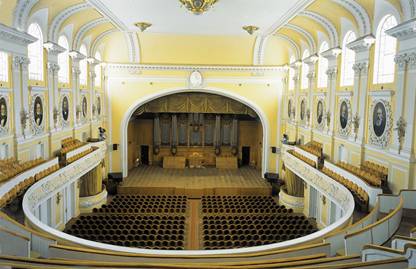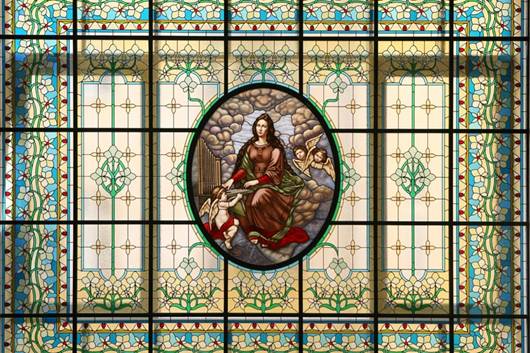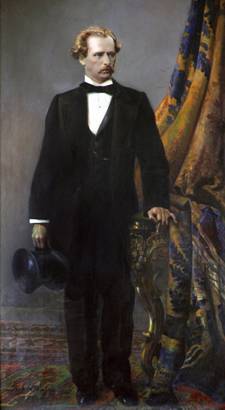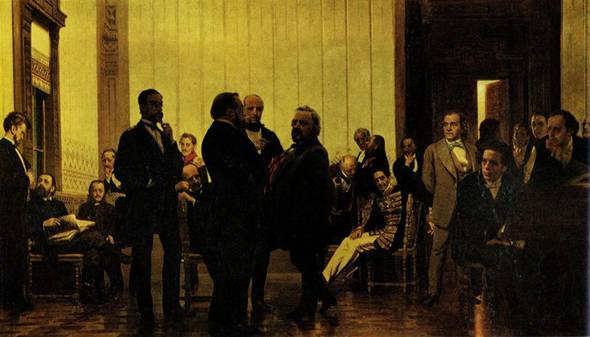

The Grand Hall, 2000s.
The Grand Hall of the Moscow Conservatory is famous across the whole world. It has ensured its reputation of being the best hall in Moscow and Russia by the combination of such favorable features as its splendid outer design and its convenient location in the city. Nevertheless, the most important attribute of the hall for musicians and listeners alike is its remarkable acoustics, for the reason of which the hall has even been called “an enormous Stradivarius violin.”
The Grand Hall of the Conservatory was inaugurated on April 7(20) 1901. The ceremonial concert began with the performance of the hymn “The Temple To Dear Art Shall be Constructed” by the Moscow Conservatory graduate, composer Feodor Feodorovich Koeneman (1873-1937), written on a poem by Nikolay Aleksandrovich Manykin-Nestruyev (1869 – ?).
The director of the Moscow Conservatory, upon whose initiative its new architectural ensemble was built, Vasily Il’ich Safonov (1852–1918), who conducted the concert, spoke the following words at the inauguration ceremony: “Let us express the wish that our hall would provide service to the glory of the art of our native land, let us wish that the great people whose pictures adorn this hall would serve as a worthy example to many generations, inspiring young characters to serve humanity”.
Many objects in the Grand Hall were built on the financial assistance of Muscovite patrons – from its furniture and rugs to the installation of the magnificent organ, which was constructed by the French company “A. Cavaillé-Coll in Paris” in 1899. Having been acknowledged to be one of the best organs of the world, back in 1900 at the World Fair in Paris, this instrument has been located up to the present time in the Grand Hall. Its front panel bears an inscription engraved in golden letters of with the name of its donor – the major railway entrepreneur Sergey Pavlovich von Dervis (1863–1943).
From the old building, which had been built by the famous architect Vasily Ivanovich Bazhenov (1737–1799), the director of the new architectural project, Vasily Petrovich Zagorsky (1846-1912) chose to preserve only the façade with the central half-rotunda, which became the symbol and emblem of the Grand Hall of the Conservatory. The small portico with the triangular fronton and bulkhead, surrounded by the colonnade, was originally intended for the approach of carriages, which is indicated by the ramps leading to it.
The first vestibule reminds of a round arched tambour, while the second, rectangular one with the ticket offices and posters, stretches along the axis of the building and leads from the main entrance, situated in the courtyard on Bolshaya Nikitskaya Street, to the back exit to the Sredny Kislovsky Side-Street.
After turning to the right and ascending the short staircase, the visitors of the Hall arrive into the main vestibule. Two statues are situated near the entrance to it, depicting Amazons – the mythical warrior women. These are copies of Ancient Greek statues of Cresilaus (on the left) and Fidius (on the right), which at one time had decorated the temple of Artemis in Ephesus. The sculptures of the great masters who had lived in the 5th century BC have not been preserved up to the present days. The moulds standing in the Grand Hall of the Conservatory were made from the Roman copies of the Ancient Greek statues.
On the opposite side of the vestibule there is a sculptural portrait of Pyotr Il’ich Tchaikovsky (1840–1893).
All in all, the vestibule was constructed in the form of an Antique temple and is divided by two rows of columns into three naves. Such architectonics has not only an aesthetical, but a practical meaning, since the compartments for the wardrobes, fringed with attached piers, are situated along the walls of the premises.
In the foyer of the vestibule the visitors may ascend any one of the two symmetrical broad staircases. They lead to an enormous window, letting in the light (5 x 4.3 meters), decorated with a beautiful stained glass with a depiction of Saint Cecilia (Caecilia Romana).

Photo by D. Rylov
In the “Report on the Construction and the Ceremonial Inauguration of the Moscow Conservatory Building” (written in Moscow in 1905) information was published about how the preparation of the stained glass for the foyer of the Grand Hall had been entrusted to the workshop of the Frank family, which were part of the Northern Society for Glass Industry.
The fate of this outstanding work turned out to be tragic. During the Great Patriotic War (World War II), in October 1941 a German high-explosive bomb fell on the building adjacent to the Conservatory. The explosion caused by it shattered the remarkable stained glass to pieces. The aperture in the wall was quickly covered. After the end of the war the spot was covered by the painting of Ilya Efimovich Repin (1844–1930), called: “Slavic Composers”, painted by him in 1871–72 for the “Slavic Bazaar” hotel and restaurant, located at the address: Nikolskaya Street 17.
Fortunately, the bas-reliefs survived with the depiction of St. Cecilia, which adorn the arched constructions over both the staircases and the boxes. They had always reminded of the beautiful benefactress of the celebrated hall.
Only 70 years afterwards, upon the initiative of the rector of the Moscow Conservatory, Professor Aleksandr Sergeyevich Sokolov, in the process of restoration of the Grand Hall in 2010-2011, it was decided to recreate the destroyed stained glass.
The project of restoration of this masterpiece was thoroughly examined at two sessions of the Academic Board of the Moscow Conservatory. As the result of the combined efforts of many enthusiastic people, the “Saint Cecilia” stained glass has been restored in its original appearance and is presently embellishing the illustrious temple of music, the Grand Hall.
The rectangular shape of the orchestra seats on the main floor is surrounded by the halls for promenades. Picturesque canvases are exhibited in them. In the foyer to the left from the hall there is a portrait of Franz Liszt (1811–1886; painter: Ilya Efimovich Repin, 1844–1930; painted in 1886).

Franz Liszt. Portrait by I. E. Repin, 1886.
In the foyer to the right of the hall there is a portrait of Nikolay Grigor’yevich Rubinstein (1835–1881; painter – Vasily Nikolayevich Yakovlev, 1893–1953; painted in 1946).

N. G. Rubinstein. Portrait by V. N. Yakovlev, 1946.
Across from the box with the seats for the Conservatory administration (N.5) we can observe the portrait of Georgy Vasil’yevich Sviridov (1915–1998; sculptor – Mikhail Konstantinovich Anikushin, 1917–1997; made in 1977). The entrance to the director’s box (N.6) is adorned by a bust of Evgeny Feodorovich Svetlanov (1928–2002; sculptor – Nikolay Aleksandrovich Kuznetsov; made in 2005).
 G. Sviridov's bust |  E. Svetlanov's bust |
The central area of the foyer n front of the orchestra seats is adorned with columns as well as beautifully fashioned lamps in the chandelier. In the lounges adjoining the halls for promenades, on the left side there are busts of composers Béla Bartók (Hungary, 1881–1945), Gheorghe Enescu (Romania, 1981–1955) and Jean Sibelius (Finland, 1865–1957), as well as wallpaper with a portrait of Giuseppe Verdi (Italy, 1813–1957).
 B. Bartók's bust |  G. Enescu's bust |
 J. Sibelius's bust |  Portrait of G. Verdi |
On the right side is the monumental painting by Repin “Slavic Composers”, which has found a new location for itself after the restoration of the building in 2011.

I. E. Repin (1844-1930). «Slavic Composers»
In the foreground Repin depicted Mikhail Ivanovich Glinka (1804–1857), Mily Alexeyevich Balakirev (1836/1837–1910), Prince Vladimir Feodorovich Odoyevsky (1804–1869) and Nikolay Andreyevich Rimsky-Korsakov (1844–1908) in a military form. In the background Aleksandr Sergeyevich Dargomyzhsky (1813–1869) is sitting on a chair, behind him there is Ivan Feodorovich Laskovsky (1799–1855) and to his right is Aleksey Feodorovich L’vov (1798–1870) in a court military uniform, listening to Aleksey Nikolayevich Verstovsky (1799–1862), who is speaking to him.
Near the piano we can see the two brothers, Anton Grigor’yevich Rubinstein (1829–1894) and Nikolay Grigor’yevich Rubinstein (1835–1881). Aleksandr Nikolayevich Serov (1820–1871) is standing between Anton Rubinstein and Aleksandr L’vov. Behind this group we can see Aleksandr L’vovich Gurilyov (1803–1858), Dmitry Stepanovich Bortnyansky (1751–1825) and Pyotr Ivanovich Turchaninov (1779–1856).
In the right-hand upper section of the picture Repin depicted a group of Polish composers: Stanisław Moniuszko (1819–1872), the farthest to the right is Frédéric Chopin (1810–1849), Michal Kleofas Ogiński (1765–1833) and Karol Lipiński (1790–1861) against the background of the door.
In the left-hand lower section of the artistic canvas there are portraits of Czech musicians: Eduard Frantsevich Nápravnik (1839–1916), who is the farthest to the left, then Bedřich Smetana (1824–1884), Karel Bendl (1838–1897) and Václav Horák (1800–1871).
The artist depicted a meeting of these musicians, many of whom had never seen and could not see each other, since they lived in different times. The painting presents an allegory, symbolizing the unity of Slavic composers.
Thousands of concert goers who attended the Grand Hall of the Conservatory have seen this most interesting group portrait of Russian, Polish and Czech musicians. However, few people know the story of its creation, described in Repin’s book “The Distant and the Near”.
Tinted in light colors, the Grand Hall captivates its visitors with its austere simplicity of its classical lines and proportions. Originally it had 1853 seats (at present there are 1852).

The arch of the stage is adorned by a medallion bas-relief with the portrait of the founder of the Moscow Conservatory Nikolay Grigor’yevich Rubinstein (1835–1881), and the frieze of the first amphitheatre presents a modeled décor with a depiction of musical instruments.

The chandelier and the lamp bracket (similarly to the metal railings on the staircases) are also decorated with musical emblems – lyre and trumpets.

An important element of the figurative decoration of the hall is presented by floral ornamentation, very characteristic of the architectural constructions of the turn of the 19th and 20th centuries – the era of the style moderne.
Under the huge semicircular windows on both sides of the hall there are portraits of great composers in the forms of medallions, which upon the injunction of Vasily Il’ich Safonov (1852–1918) were made by painter Nikolay Kornilyevich Bodarevsky (1850–1921). The succession of the portraits was originally as follows: to the left, beginning with the stage was Pyotr Il’ich Tchaikovsky (1840–1893), Ludwig van Beethoven (1770–1827), George Frederic Handel (1685–1759), Franz Schubert (1797–1828), Robert Schumann (1810–1856), Christoph Willibald von Gluck (1714–1787) and Anton Grigor’yevich Rubinstein (1829–1894); to the right were Mikhail Ivanovich Glinka (1804–1857), Johann Sebastian Bach (1685–1750), Wolfgang Amadeus Mozart (1756–1791), Joseph Haydn (1732–1809), Felix Mendelssohn (1809–1847), Richard Wagner (1813–1883) and Aleksandr Porfiryevich Borodin (1833–1887).
In 1953 upon the decision of the government of the USSR, the images of Christoph Willibald Glűck and Felix Mendelssohn, were replaced by portraits of Frédéric Chopin (1810-1849) and Nikolay Andreyevich Rimsky-Korsakov (1844–1908) pertaining to the paintbrush of Mikhail Arkadyevich Suzdaltsev (1917–1998), and the image or George Frederic Handel was replaced by the portraits of Modest Petrovich Musorgsky (1839–1881) and Aleksandr Dargomyzhsky (1813–1869), painted by of Nikolay Petrovich Meshchaninov (1913–1967).
Towards the centennial anniversary of the Grand Hall of the Conservatory in 2001, the portraits of Haydn and Mendelssohn, accidentally found in the storehouse, were restored and placed in the foyer of the orchestra seats. After the completion of the major repairs of the Grand Hall of the Conservatory, a model of the hall was placed near them, made in 2010 for the sake of controlling the process of preservation of its remarkable acoustics.
In the history of our country there have been period of time when the Grand Hall was made use of in means not corresponding with its main purpose. Thus, during World War I a military hospital was organized here, while from 1924 to 1933, during the daytime hours, the movie theater “Colossus” worked on the premises.
During the course of over 100 years musicians of all countries who performed in Moscow have given preference to this magnificent hall, which has become the center of musical life in the capital of Russia. The international P.I. Tchaikovsky Competition, which since 1958 has been one of the most important events in the world music scene, has been inseparably connected with the Moscow State P.I. Tchaikovsky Conservatory, its traditional venue. Here during various years numerous festive ceremonies of opening and closing the competition, auditions of the pianists, violinists and cellists, as well as the final concert of the winners have taken place.
Upon the decision of the Advisory Board of the Conservatory from November 28, 2006, the building of the Grand Hall was given the name of the founder of the Moscow Conservatory, Nikolay Grigor’yevich Rubinstein.